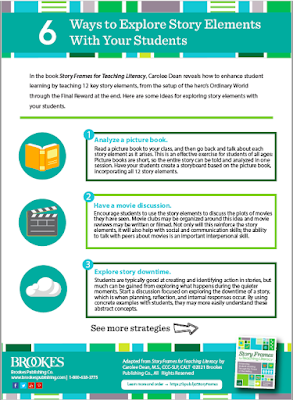Carolee Dean's Blog, page 13
April 26, 2021
BOOKS FOR KIDS WRITTEN BY PEOPLE WITH AUTISM
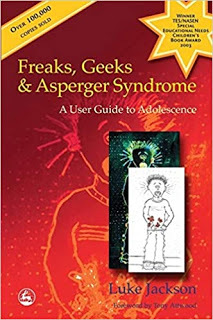
Freaks, Geeks, and Asperger Syndrome: A User Guide to Adolescence was written by Luke Jackson when he was 13 years old. He has Asperger Syndrome and also has a brother on the autism spectrum and another with AD/HD. His book provides tips on bullying, friendship, dating, and relationships. He also talks about how and when to talk to others about being on the autism spectrum. The insights this book provides are useful to parents and teachers as well as to people with AS. The book is 216 pages long and for ages 11-18.
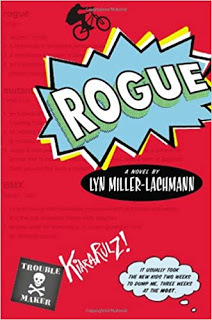
In Rogue by Lyn Miller-Lachmann. Kiara, an eighth-grade girl with Asperger’s is shunned at school and expelled after a violent outburst. She finds friendship with a neighbor boy until dark family secrets (his parents run a meth lab) threaten to destroy more than the budding kinship. Kiara finds inspiration with the X-Men character, Rogue (a mutant who unintentionally hurts anyone she touches until she learns to control her superpower). Kiara eventually discovers that she might just have special gifts of her own- The author, Lyn Miller-Lachmann, has Asperger’s Syndrome which lends authenticity and perspective to the story. Read my interview with Lyn HERE. 241 pages for grades 5-10.
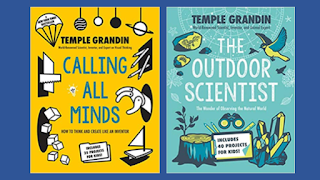
Out just this month (April 6) is a new book by Temple Grandin- The Outdoor Scientist: The Wonder of Observing the Natural World. This book is 208 pages long for grades 3-7 and contains 40 outdoor projects as well as information about Temple and other scientists who explore the natural world.
Calling All Minds: How to Think and Create Like an Inventor, also by Temple Grandin, looks at the science and methodology behind various inventions and shows kids how to think like an inventor. Temple talks about the inventions she created as a child. It is 240 pages long and is for kids in grades 3-7. Read more about Temple Grandin and her other books in last week's post.
See books for kids written about the life of Temple Grandin in my April 11 Blog Post.
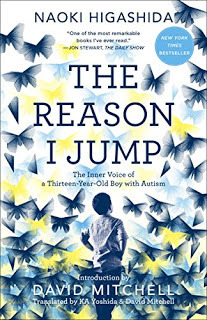
This last book is not specifically written for kids. It has received both criticism and accolades. I will share both sides of the conversation. The Reason I Jump: The Inner Voice of a Thirteen-Year-Old Boy With Autism was written by Naoki Higashida, a thirteen-year-old boy on the spectrum. He is described as being nonverbal, though to clarify, he is able to read out loud as is described by the translator, David Mitchell in the notes at the end of the book. It is unscripted conversations with which Naoki struggles. Even answering simple questions verbally is a challenge. He reportedly wrote his book (a Q&A interspersed with short, fictional stories) by pointing to letters on an alphabet grid that someone else transcribed into words and sentences. The book has received praise for providing unique insights into autism. It has also received criticism by those who question the validity of the methods used to elicit the answers to the Q&A saying it feels a bit too much like Facilitated Communication (FC) which has been debunked as pseudoscience. In FC an assistant guides and supports the hand of a non-verbal person as they point to letters. That was not the case with Naoki, but he did point to letters on a board in response to questions as opposed to typing them on a computer keyboard or communication device.
ASHA (American Speech-Language-Hearing Association) discourages the use FC and Spelling to Communicate. Read the ASHA perspective to learn why. They do support independent typing as well as other forms of augmentative and alternative communication that are more independent in nature.
David Mitchell, the best-selling author of Cloud Atlas, translated Why I Jump into English with his wife, K.A. Yoshida. Mitchell appears in a video interview talking about his experience with the translation. He first became acquainted with Naoki's story when trying to better understand his own son with autism. He then set out to translate the book from Japanese into English so that he could share the story and its insights with his son's teachers. Watch his interview on YouTube and read his Q&A HERE.
At the end of the English translation of the book, Mitchell talks about conversations he has had with Naoki using his communication board. He also says that Naoki is a motivational speaker who reads aloud from a prepared script. He does not answer questions from the audience verbally, though. He types those responses. I looked on YouTube but could not find any examples of these motivational talks. If anyone is aware of any, I would like to know.
A 2020 documentary film of the same title inspired by the book features 5 other young people with autism. Watch the TRAILER to learn more.
Read this blog post by the National Council on Severe Autism which raises concerns about the movie.
April 17, 2021
INTERVIEW WITH LYN MILLER-LACHMANN (Talking About Asperger Syndrome)

Lyn Miller-Lachmann is the author of the middle grade and young adult novels Gringolandia, Surviving Santiago, and Rogue, with two new novels, Moonwalking and Torch, forthcoming in 2022. She also edited Once Upon a Cuento which is a collection of short stories for young readers written by emerging Latino authors. She lives in New York City. She is joining me today to talk about her young adult novel, Rogue.
Carolee: How did your experiences with having Asperger’s impact writing Rogue, a story about a girl with Asperger Syndrome?
Lyn: I was diagnosed with Asperger’s 15 years ago, a diagnosis that has since 2013 been folded into the autism spectrum. At that time, I’d published one novel, with another recently accepted by the same publisher. Neither of them had autobiographical elements; in fact, I’d avoided writing a protagonist like myself because I didn’t want to remember the bullying and exclusion I experienced as a child. My diagnosis changed that. Finally, I had an answer for why I was different, why I had trouble understanding and following rules, why so many of my peers took advantage of me or bullied me for sport. I wanted to write a novel to show kids like me that they are not alone. Rogue is based on a choice I had to make when I wasn’t much older than Kiara—to keep doing something I knew was dangerous and wrong in order to be part of a group, or to stop letting these kids use me even if it meant being on my own and bullied again.
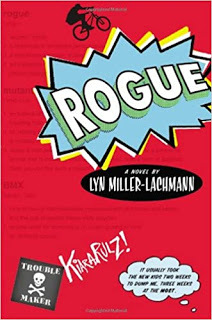
Carolee: It was very brave of you to share so much of your personal experience in the story. One of the benefits of writing about our personal experiences through fiction is that the reader connects with the truth and honesty behind what we write, but at the same time never knows how much of the story is truth and how much is fiction. Why did you decide to write about your experiences as fiction rather than as a traditional autobiography?
Lyn: I’ve fictionalized in service to the story, in order to create a book that readers will want to read. In Rogue, I began with a “What if?” Like Kiara, I tried to sit at the popular girls’ table in seventh grade thinking that’s how I could become popular, and one of the girls pushed my lunch tray to the floor. I did nothing in response, just stood there crying, but for decades I asked myself what would have happened if I’d picked up the tray and smacked her in the face with it. I would have salvaged my dignity, but I would have also gotten into a lot of trouble. So at the beginning of Rogue, Kiara does pick up the tray and hit the bully with it. And it creates a big problem for her, because she’s suspended for the rest of the school year. She wants to have friends and to belong to a group, but now she’s even more isolated, and the New Kid who moves in around the corner really is her last chance to make a friend for a long time.
Carolee: Amy Miller, director of the May Center in Santa Fe, NM, wrote a chapter for my new book, Story Frames for Teaching Literacy. Her chapter is “Fostering a Growth Mindset: Strengths-Based Super Hero Stories.” The May School is for students with learning differences. Amy heads a project called The Dyslexia Justice League and one of the ways she helps students to discover their “superpower” is to teach them to write superhero stories. In Rogue, the main character, Kiara, finds that she has special talents and unique gifts. She does this partly by identifying with the mutant X-Men character named Rogue. Do you have any suggestions for young writers about writing their own superhero stories or about writing stories in general?
Lyn: No matter what you write, the most important thing to do is to read. It will give you ideas and help you figure out what kinds of stories and characters you like and don’t like. A lot of times, the characters that feel closest to you—whether or not they’re superheroes—are the ones most like you. For instance, the X-Men character Rogue is most like Kiara because she can’t touch or be touched and she learns about emotions and what to say or do from watching others. Sometimes, the characters you respond to are the ones who do the things you wish you could do, like be good at sports if you are not. Writing your own story is your chance to be someone different, or be yourself but rewrite the past or possess a special power you don’t have in real life and see what you can accomplish with it.
Carolee: Speaking of heroes, early in Rogue, a friend of Kiara’s family gives her a book by Temple Grandin entitled Animals in Translation: Using the Mysteries of Autism to Decode Animal Behavior. She tells Kiara that Temple has a “special talent” for understanding animals. Temple Grandin, an animal scientist on the autism spectrum, becomes a role model and a hero of sorts to Kiara. Tell us a little bit about the people who have been your real-life heroes.
Lyn: Temple Grandin is one of my heroes as well, ever since I read Dr. Oliver Sacks’s profile of her in The New Yorker in the 1990s and recognized so much of myself in her. Although I wasn’t diagnosed until almost ten years later, it meant a lot to me to see someone who had become as successful as she had and whose different ways of seeing the world has had such an impact on the way we treat the animals we raise for food. In general, my heroes are people who have defied convention and authority to make a positive impact on the world. Many of them are human rights activists, people who have resisted brutal dictatorships to bring democracy to their countries (like my protagonist’s father in another one of my novels, Gringolandia) or who have fought for the rights of people with disabilities and others who have been excluded or faced discrimination.
Carolee: Is there anything else you would like to say to young people struggling to find their place in the world?
Lyn: Do what you love, pursue your dreams, and find the people who understand you. And when you do find those people, try to be a good friend as well. Being a good friend is one of the things I still strive (and sometimes struggle) to do. It’s at the heart of Kiara’s journey in Rogue and of JJ’s journey in my forthcoming middle-grade verse novel Moonwalking, which I’ve written with my friend Zetta Elliott.
Carolee: Thank you for joining us and for sharing your experiences as a person with Asperger’s. I have thoroughly enjoyed reading Rogue and look forward to Moonwalking and Torch. You are a hero who is making a positive impact on the world with your stories!
Lyn: Thank you for inviting me!
Read about books for kids written by Temple Grandin in last week's post as well as books written about her life - Books for Kids by (and about) Temple Grandin - Celebrating World Autism Month.
INTERVIEW WITH LYN MILLER-LACHMANN (Author with Asperger Syndrome)

Lyn Miller-Lachmann is the author of the middle grade and young adult novels Gringolandia, Surviving Santiago, and Rogue, with two new novels, Moonwalking and Torch, forthcoming in 2022. She also edited Once Upon a Cuento which is a collection of short stories for young readers written by emerging Latino authors. She lives in New York City. She is joining me today to talk about her young adult novel, Rogue.
Carolee: How did your experiences with having Asperger’s impact writing Rogue, a story about a girl with Asperger Syndrome?
Lyn: I was diagnosed with Asperger’s 15 years ago, a diagnosis that has since 2013 been folded into the autism spectrum. At that time, I’d published one novel, with another recently accepted by the same publisher. Neither of them had autobiographical elements; in fact, I’d avoided writing a protagonist like myself because I didn’t want to remember the bullying and exclusion I experienced as a child. My diagnosis changed that. Finally, I had an answer for why I was different, why I had trouble understanding and following rules, why so many of my peers took advantage of me or bullied me for sport. I wanted to write a novel to show kids like me that they are not alone. Rogue is based on a choice I had to make when I wasn’t much older than Kiara—to keep doing something I knew was dangerous and wrong in order to be part of a group, or to stop letting these kids use me even if it meant being on my own and bullied again.

Carolee: It was very brave of you to share so much of your personal experience in the story. One of the benefits of writing about our personal experiences through fiction is that the reader connects with the truth and honesty behind what we write, but at the same time never knows how much of the story is truth and how much is fiction. Why did you decide to write about your experiences as fiction rather than as a traditional autobiography?
Lyn: I’ve fictionalized in service to the story, in order to create a book that readers will want to read. In Rogue, I began with a “What if?” Like Kiara, I tried to sit at the popular girls’ table in seventh grade thinking that’s how I could become popular, and one of the girls pushed my lunch tray to the floor. I did nothing in response, just stood there crying, but for decades I asked myself what would have happened if I’d picked up the tray and smacked her in the face with it. I would have salvaged my dignity, but I would have also gotten into a lot of trouble. So at the beginning of Rogue, Kiara does pick up the tray and hit the bully with it. And it creates a big problem for her, because she’s suspended for the rest of the school year. She wants to have friends and to belong to a group, but now she’s even more isolated, and the New Kid who moves in around the corner really is her last chance to make a friend for a long time.
Carolee: Amy Miller, director of the May Center in Santa Fe, NM, wrote a chapter for my new book, Story Frames for Teaching Literacy. Her chapter is “Fostering a Growth Mindset: Strengths-Based Super Hero Stories.” The May School is for students with learning differences. Amy heads a project called The Dyslexia Justice League and one of the ways she helps students to discover their “superpower” is to teach them to write superhero stories. In Rogue, the main character, Kiara, finds that she has special talents and unique gifts. She does this partly by identifying with the mutant X-Men character named Rogue. Do you have any suggestions for young writers about writing their own superhero stories or about writing stories in general?
Lyn: No matter what you write, the most important thing to do is to read. It will give you ideas and help you figure out what kinds of stories and characters you like and don’t like. A lot of times, the characters that feel closest to you—whether or not they’re superheroes—are the ones most like you. For instance, the X-Men character Rogue is most like Kiara because she can’t touch or be touched and she learns about emotions and what to say or do from watching others. Sometimes, the characters you respond to are the ones who do the things you wish you could do, like be good at sports if you are not. Writing your own story is your chance to be someone different, or be yourself but rewrite the past or possess a special power you don’t have in real life and see what you can accomplish with it.
Carolee: Speaking of heroes, early in Rogue, a friend of Kiara’s family gives her a book by Temple Grandin entitled Animals in Translation: Using the Mysteries of Autism to Decode Animal Behavior. She tells Kiara that Temple has a “special talent” for understanding animals. Temple Grandin, an animal scientist on the autism spectrum, becomes a role model and a hero of sorts to Kiara. Tell us a little bit about the people who have been your real-life heroes.
Lyn: Temple Grandin is one of my heroes as well, ever since I read Dr. Oliver Sacks’s profile of her in The New Yorker in the 1990s and recognized so much of myself in her. Although I wasn’t diagnosed until almost ten years later, it meant a lot to me to see someone who had become as successful as she had and whose different ways of seeing the world has had such an impact on the way we treat the animals we raise for food. In general, my heroes are people who have defied convention and authority to make a positive impact on the world. Many of them are human rights activists, people who have resisted brutal dictatorships to bring democracy to their countries (like my protagonist’s father in another one of my novels, Gringolandia) or who have fought for the rights of people with disabilities and others who have been excluded or faced discrimination.
Carolee: Is there anything else you would like to say to young people struggling to find their place in the world?
Lyn: Do what you love, pursue your dreams, and find the people who understand you. And when you do find those people, try to be a good friend as well. Being a good friend is one of the things I still strive (and sometimes struggle) to do. It’s at the heart of Kiara’s journey in Rogue and of JJ’s journey in my forthcoming middle-grade verse novel Moonwalking, which I’ve written with my friend Zetta Elliott.
Carolee: Thank you for joining us and for sharing your experiences as a person with Asperger’s. I have thoroughly enjoyed reading Rogue and look forward to Moonwalking and Torch. You are a hero who is making a positive impact on the world with your stories!
Lyn: Thank you for inviting me!
Read about books for kids written by Temple Grandin in last week's post as well as books written about her life - Books for Kids by (and about) Temple Grandin - Celebrating World Autism Month.
April 11, 2021
BOOKS FOR KIDS by (and about) TEMPLE GRANDIN - CELEBRATING WORLD AUTISM MONTH
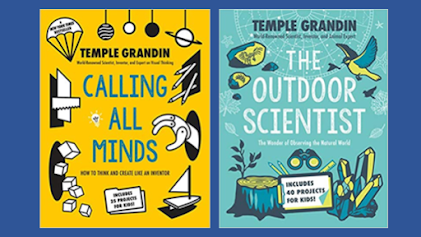
Temple Grandin is a professor of animal sciences at Colorado State University and specializes in the humane treatment of livestock animals. She has written numerous scientific papers about the humane treatment of animals as well as books about caring for animals such as Animals Make Us Human: Creating the Best Life for Animals.
Temple is also autistic and often speaks at educational conferences about her experiences growing up on the spectrum. She has written books on that subject for adult audiences such as Thinking in Pictures: My Life with Autism and Emergence: Labeled Autistic.
She has also written books for kids, mostly about the sciences, but weaving in her personal experiences such as Calling All Minds: How to Think and Create Like an Inventor pictured above. This book looks at the science and methodology behind various inventions and shows kids how to think like an inventor. Temple talks about the inventions she created as a child. It is 240 pages long and is for kids in grades 3-7.
Out just this past week is a new book by Temple - The Outdoor Scientist: The Wonder of Observing the Natural World. pictured above. This book is 208 pages long for grades 3-7 and contains 40 outdoor projects as well as information about Temple and other scientists who explore the natural world.

Many other people have written books for children about Temple Grandin and her experiences with autism. How to Build a Hug: Temple Grandin and Her Amazing Squeeze Machine written by Amy Guglielmo and Jacqueline Tourville and illustrated by Giselle Potter, is a 48-page picture book for grades PreK-3.
The Girl Who Thought In Picture: The Story of Dr. Temple Grandin (Amazing Scientists) written by Julia Finley Mosca and illustrated by Daniel Rieley is for grades K-5 is told in rhyme with cartoon illustrations and is 40 pages in length.
For middle-grade readers, there is Who Is Temple Grandin? written by Patricia Brennan DeMuth and illustrated by Robert Squler. This book is from the Who Was series and is 112 pages in length for grades 3-7. The black and white illustrations provide a nice addition to the story. It is written like a narrative of Temple's life from her early struggles with autism to her great achievements as an adult.
Temple Grandin: How the Girl Who Loved Cows Embraced Autism and Changed the World by Sy Montgomery has a foreword written by Temple Grandin. It is 160 pages long and for grades 5-7 and is written as traditional non-fiction with numerous facts and photographs.
Watch for next week's post where I will interview another author on the autism spectrum - Lyn Miller-Lachmann who has been diagnosed with Asperger Syndrome. Her book, Rogue, is for grades 7-10 and features a main character with Asperger's who identifies with the X-Men character, Rogue, because she has so much trouble fitting in with her peers. She eventually discovers her own unique gifts and this helps her begin to find her place in the world.
April 2, 2021
WORLD AUTISM AWARENESS DAY & BOOK BIRTHDAY For STORY FRAMES
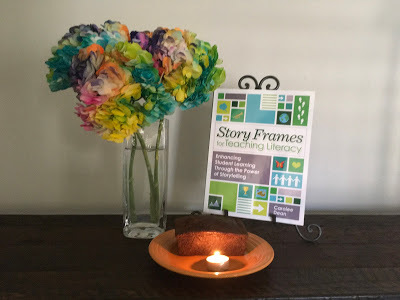
It's April 2, 2021 - World Autism Awareness Day and the start of World Autism Awareness Month. You can find out more about how to increase understanding and awareness of autism at autismspeaks.org. In future blog posts, I will be talking about how to use narratives to work with students on the autism spectrum and sharing children's books featuring main characters with autism, but for now, I would like to take a minute to celebrate the official book birthday for Story Frames for Teaching Literacy which is now available at Brookes Publishing and also at amazon.com It is already out of stock at Amazon, but they will be getting more books in soon. You may also order this title through any bookstore if you want to support local retailers.
According to today's Amazon rating, Story Frames is #1 in Elementary Education. Yesterday, based on pre-orders, it was the #1 new release in Special Education.
HAPPY BOOK BIRTHDAY STORY FRAMES!!
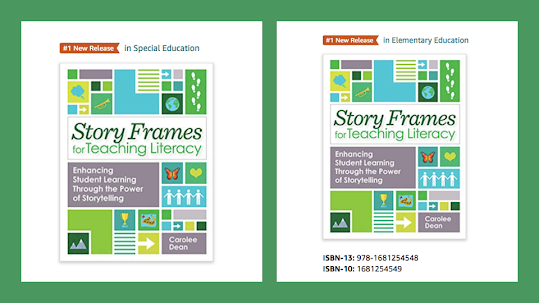 Amazon Ratings 4/1/21 and 4/2/21
Amazon Ratings 4/1/21 and 4/2/21Thank you to my friend, Jill, for the lovely birthday lunch and the flowers in the photo above. Thanks to all of my friends, family, colleagues, and the amazing team at Brookes Publishing who have supported this project throughout the years. Remember, if you sign up for my online newsletter, you will receive a code for 20% off of Story Frames when the next edition of my newsletter comes out later in April.
Brookes Publishing hosted a live webinar/coffee chat last Wednesday where I had the chance to talk about Story Frames and answer questions about the book. Later this month I will post a link to the recording of that webinar.
Before I go, I want to give a shout-out to the most famous person with autism that I know, the amazing Temple Grandin. There are several books written about her for children including the following:
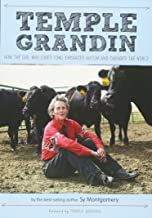
Temple Grandin: How the Girl Who Loved Cows Embraced Autism and Changed the World by Sy Montgomery. It is 160 pages long and for grades 5-7. Watch for next week's post where I will share more children's books about Temple. Bye for now - I have more celebrating to do!
March 25, 2021
THE FAMILY STORY - INTERVIEW WITH PARENT ADVOCATE MARY JO O'NEILL
Mary Jo O’Neill, M.Ed. Is a Special Education Advocate at Hickman & Lowder Company in Cleveland, Ohio. As an educational advocate, Mary Jo works with families of children with learning disabilities. Her background as a teacher and intervention specialist supports collaboration with teachers, administrators, and school systems to work together to create and implement the best systems and tools for successful learning. She is a contributing author for my new book on story structure, Story Frames for Teaching Literacy. She was generous enough to give a video interview to talk about how she helps families write their family stories. The video and transcript are below.
If the video does not display correctly, you may also find it on YouTube.
INTERVIEW WITH MARY JO O’NEILL, M.ED., PARENT ADVOCATE - VIDEO TRANSCRIPT
Carolee: Good morning, Mary Jo. Thank you so much for being here with me to talk about my book and thank you for being a contributor.
Mary Jo: Thank you for having me. It’s exciting for the families. It’s exciting for the educators.
Carolee: My book is Story Frames for Teaching Literacy: Enhancing Student Learning Through the Power of Storytelling and the chapter you’ve written is “Advocating for Students: The Family Story.” In just a minute, I’m going to ask you to talk about your role as an advocate, what that means, and who you advocate for, but before we do that, I have a little story to share about how we met.
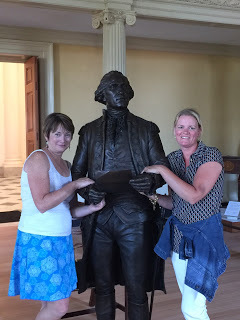
Carolee: Here we are in Annapolis with either George Washington or Thomas Jefferson, I’m not sure who. We were in Annapolis in 2015, along with Paula Moraine, who is also a contributing author for my book. We were there for the Destiny Meeting of the International Dyslexia Association and we were working on strategic planning for the organization. At that time, I was the president of the Southwest Branch.
Mary Jo: And I was president of the Northern Ohio Branch.
Carolee: Your chapter is in a section of my book dedicated to “The Power of the Personal Narrative.” I’ve always been involved in stories. I’m an author of young adult novels, and as a speech-language pathologist working in the public schools for twenty years, I often used stories as a medium to work on expressive and receptive language, but I was surprised to find out that writing stories was a part of your job as a parent advocate. Tell us about that. That is fascinating to me.
Mary Jo: When a parent comes to us, there is a journey. The IEP (Individualized Educational Program) process, the special education process, are pieces to the puzzle. I need to listen to their story and find out where they are in that process. Are they at the planning meeting stage? Are they at the ETR (Evaluation Team Report) pieces? Are they receiving a 504 plan? I need to actively listen to where they are, if their needs are being met, and find out how they are feeling about the process. Then I take that information and we go back to the district, and we collaborate together to make sure that their child’s needs are being met.
Carolee: You have a whole process of writing a story with the family. That’s what you talk about in my book. How do you actually come up with the story that they write that they then share with the school?
Mary Jo: I call it a non-emotional timeline. It gives us the beginning, middle, and end of their story. When did they implement Orton-Gillingham instruction? When did they add occupational therapy? We bring that story to the school district and the district might have some “aha” moments. “Oh, I didn’t know you were doing speech-language therapy at home. I didn’t realize you were doing occupational therapy? It brings the story together.
Carolee: Does the school have their own story, their own perspective or version of events?
Mary Jo: Yes, they do have their own story, and their story matters. When that student is in speech-language therapy maybe twice a week at school, and then the child is getting speech twice a week at home, we may be wondering why he is so emotionally drained when he comes home, and it might be because he’s having speech four times a week. It may not have been necessary, or maybe it was, but either way, he is emotionally drained. Listening to everybody’s story helps us figure out what’s happening throughout his day - during the school day at home.
Carolee: That perspective-taking is something that I have found is one of the most valuable aspects of getting kids to read a variety of stories from different people, different cultures, and different backgrounds. That ability to take other people’s perspectives, not only take the perspective but to honor that perspective. That is something that we need very much in our world right now. Perspective-taking through stories, writing your own story to share your perspective, reading other people’s stories to learn theirs, is invaluable. Tell us a little bit about that perspective-taking.
Mary Jo: Everyone has their version of the narrative. We need to respect the educator’s version and we also need to respect the parents’ version. By bringing those stories together we are able to understand the child’s learning patterns and we are able to put in place better instruction, which will only support the child.
Carolee: Mary Jo, thank you so much for sharing how you advocate for smilies through stories. This has been such an invaluable addition to my book and I hope that parents are inspired and empowered now to share their stories. Thank you so much.
Mary Jo: Thank you for having me.
To receive a code for 20% off of Story Frames in my March and April newsletters and receive a free story template, sign up for my mailing list.
Q & A With Brookes Publishing
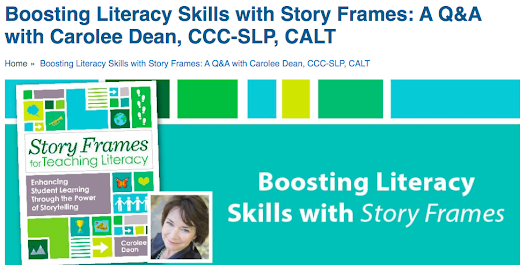 Q. Your book explores the ways in which analyzing and creating stories can improve literacy and learning skills for all students. How does the process of mastering storytelling help boost those critical skills?
Q. Your book explores the ways in which analyzing and creating stories can improve literacy and learning skills for all students. How does the process of mastering storytelling help boost those critical skills?A. As a speech-language pathologist, anytime I evaluate a student’s receptive and expressive language I look at how they express themselves in connected discourse. Retelling a story is often part of that process. The ability to retell a story or create an original narrative are important skills for both school and life. Standardized tests have even been created to measure these abilities, and I discuss some of these tests in my book.
Understanding story structure gives kids a framework to organize a narrative that helps them determine which details to prioritize so they can recall those details, sequence information, make meaning out of new words and concepts, and learn to self-question to assess their own comprehension.
Stories are part of our daily lives. Families members tell stories to connect with each other, share their history, and to inform. Peers share stories to build relationships. Educators use stories to teach. Marketers use stories to persuade. Lawyers use stories to prove guilt or innocence. Detectives interview witnesses and use their stories to solve crimes. Stories help us to take the perspective of others, organize the events of our life, and make meaning from chaos.
I have found that struggling learners typically have two approaches to retelling a story. Either they have no frame of reference for the events, shrug their shoulders and say, “I don’t know,” or else they feel they must start at the beginning and include every single detail they can remember. Both responses stem from not understanding the basic structure of a narrative and what elements are essential to include in a retelling. When a student understands that structure, they then have a framework for organizing all kinds of narratives—those they encounter in school and those they encounter in everyday life. Consider how many core subjects use stories to convey information on topics as diverse as the Revolutionary War to space flight...
For the rest of the Q & A, visit the Brookes website. To receive a code for 20% off of Story Frames in my March and April newsletters and receive a free story template, sign up for my mailing list.
March 21, 2021
PARTY TIME - MY NEW BOOK HAS ARRIVED!
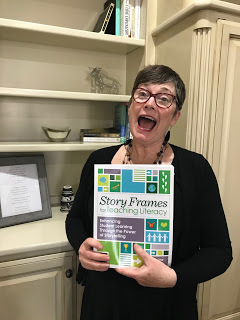
A box arrived this morning and I opened it to find my preview copies of Story Frames for Teaching Literacy - 270 pages of my heart and soul - plus about 80 pages of additional online material. I lost count somewhere along the way! It is available for sale to the public on April 2, 2021, at Brookes and on Amazon.
This book is the culmination of two decades of work as a young adult author and a speech-language pathologist in the public schools as well as in my private practice working with students with dyslexia.
Here I am below, looking a little more composed.
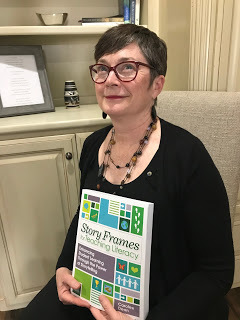
In Story Frames, I combine my insights as a fiction novelist with my experience working with struggling learners to show students how to think and create stories like a professional writer. I owe a debt of gratitude to the parents and students who allowed me to share their stories in my book. Thank you to all my students, young and old, who inspired me to find a method to teach storytelling and writing that is accessible to anyone.
Here is a little secret - I use the same basic strategies with first graders, middle school students, and teens as I do when I teach novel plotting to adults who want to become professionally published authors. I am able to do this because almost all stories (movies, novels, and even picture books) are based on a universal structure found in myths and fairy around the world.
I shared these strategies with my friend and fellow author, Jennifer Cervantes (as best-selling author of the Storm Runner series she goes by J.C. Cervantes), and she used the strategies to teach her college literature students the structure of stories.
"I used this text with my university students to illustrate story structure as well as highlight the most important elements of a hero’s journey." - Jennifer Cervantes
Whether you are young or old, a published author or a struggling writer, whether you want to publish the next great novel or simply want to preserve your personal family stories, I hope you find inspiration from my little book.
To find out more about Story Frames, please join me on March 31 for an online Coffee Chat hosted by Brookes Publishing. Register for the Coffee Chat HERE. Sign up for my mailing list HERE and get a code in my April Newsletter for 20% off of Story Frames.
Now I have to go. It's party time! My new book has arrived.
Happy Writing!
March 14, 2021
GET 20% OFF OF STORY FRAMES
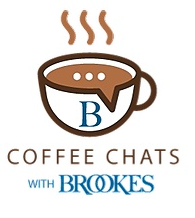 Get a discount code for 20% off of my new book, Story Frames for Teaching Literacy, in my March and April Newsletters when you join my MAILING LIST. You may unsubscribe at any time. You will also receive a free fill-in-the-blank story template called Travel Trouble.
Get a discount code for 20% off of my new book, Story Frames for Teaching Literacy, in my March and April Newsletters when you join my MAILING LIST. You may unsubscribe at any time. You will also receive a free fill-in-the-blank story template called Travel Trouble.I'm also excited to announce that I will be holding a live online Coffee Chat with Brookes Publishing on Wednesday, March 31, 2021 from 1:00 - 1:45. Register HERE. The description from Brookes is below:

Presented by: Carolee Dean, M.S., CCC-SLP, CALT, Speech-Language Pathologist, Certified Academic Language Therapist, Dyslexia Therapist Age range: Upper elementary (3–5) Who this chat is for: teachers, speech-language pathologists, dyslexia tutors, and therapists Analyzing and creating stories can boost critical literacy skills for all learners—and this engaging and informative coffee chat will show you how. Presented by Carolee Dean, author of the new book Story Frames for Teaching Literacy, this must-see chat introduces you to the twelve elements found in almost all stories and reveals how to teach these elements effectively to your students. Through an overview of the book, Dean will emphasize ways you can use narratives to help students with a variety of learning objectives, such as improving comprehension, written language, and other key skills. ATTENDEES WILL: • Learn the underlying structure present in almost all stories—and explore how to effectively teach this structure to students to improve comprehension
• Understand how using the context of a story facilitates vocabulary development
• Explore how teaching self-questioning (and other strategies) improves both comprehension and written language
• Discover activities that will inspire even the most reluctant writers
March 7, 2021
6 WAYS TO EXPLORE STORY ELEMENTS WITH YOUR STUDENTS
Brookes Publishing has created a lovely two-page handout entitled, 6 Ways to Explore Story Elements With Your Students. It's a great visual to share with teachers, librarians, and school administrators especially if you are requesting funds to purchase my new book - Story Frames for Teaching Literacy. The publisher and I have worked hard to keep this resource affordable by creating a robust downloads section with power points, activity sheets, and book synopses. It is due for publication in early April of 2021.
To learn more about how film structure inspired me to write this book, check out my previous blog post Screenwriting and Novel Plotting: The Inspiration Behind Story Frames.
Each section of Story Frames starts with the evidence base behind the strategies for that chapter and there are links to the Common Core State Standards throughout. There is also a lengthy reference section at the end. Go to the Brookes Website to get the downloadable version of this handout and don't forget to sign up for my NEWSLETTER to receive a free Story Template if you have not already done so.
